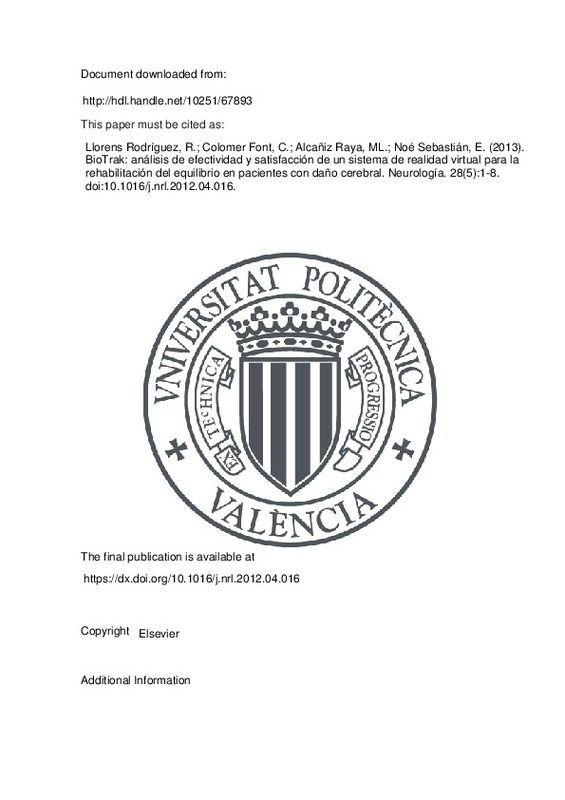Llorens Rodríguez, R.; Colomer Font, C.; Alcañiz Raya, ML.; Noé Sebastián, E. (2013). BioTrak: análisis de efectividad y satisfacción de un sistema de realidad virtual para la rehabilitación del equilibrio en pacientes con daño cerebral. Neurología. 28(5):1-8. https://doi.org/10.1016/j.nrl.2012.04.016
Por favor, use este identificador para citar o enlazar este ítem: http://hdl.handle.net/10251/67893
|
Título:
|
BioTrak: análisis de efectividad y satisfacción de un sistema de realidad virtual para la rehabilitación del equilibrio en pacientes con daño cerebral
|
|
Otro titulo:
|
BioTrak virtual reality system: effectiveness and satisfaction analysis for balance rehabilitation in patients with brain injury
|
|
Autor:
|

 Llorens Rodríguez, Roberto
Colomer Font, Carolina
Llorens Rodríguez, Roberto
Colomer Font, Carolina

 Alcañiz Raya, Mariano Luis
Noé Sebastián, Enrique
Alcañiz Raya, Mariano Luis
Noé Sebastián, Enrique
|
|
Entidad UPV:
|
Universitat Politècnica de València. Instituto Interuniversitario de Investigación en Bioingeniería y Tecnología Orientada al Ser Humano - Institut Interuniversitari d'Investigació en Bioenginyeria i Tecnologia Orientada a l'Ésser Humà
Universitat Politècnica de València. Escuela Técnica Superior de Ingeniería Agronómica y del Medio Natural - Escola Tècnica Superior d'Enginyeria Agronòmica i del Medi Natural
|
|
Fecha difusión:
|
|
|
Resumen:
|
[EN] Objective: To study effectiveness of and satisfaction with a virtual reality-based balance rehabilitation system (BioTrak) for patients with acquired brain injury (ABI). Material and methods: Ten patients with chronic ...[+]
[EN] Objective: To study effectiveness of and satisfaction with a virtual reality-based balance rehabilitation system (BioTrak) for patients with acquired brain injury (ABI). Material and methods: Ten patients with chronic hemiparesis (chronicity > 6 months) following an ABI completed a 20-session programme using the balance reaching-task module of the BioTrak system. All patients were assessed at baseline, at the end of treatment and one month later with the Berg Balance Scale (BBS), the Tinetti Performance-Oriented Mobility Assessment (POMA), and the computerised posturography tool NedSVE/IBV. The posturography study included analysis of sensory indexes, limits of stability and rhythmic weight shift. The usability study was conducted using an ad hoc questionnaire. Results: Repeated measures ANOVA showed a significant improvement in BBS (P < .01), TBS (P < .01), vestibular index (P < .05), and anterior-posterior weight shift (P < .05); a trend in the same direction was also found for medial lateral weight shift (P = .059). The post-hoc analysis revealed significant improvement between the initial and final assessments for BBS, POMA and anterior-posterior weight shift control; gains remained a month after completing the programme. The system showed a high degree of usability in terms of presence, immersion and user-friendliness, and there was a significant absence of adverse effects. Conclusion: Our results confirm the utility of virtual reality systems for balance rehabilitation in this population. Usability data suggest that BioTrak could be adapted for use in multiple rehabilitation settings by a high number of patients. © 2011 Sociedad Española de Neurología
[-]
|
|
Palabras clave:
|
Balance
,
Brain injury
,
Rehabilitation
,
Stroke
,
Usability
,
Virtual reality
|
|
Derechos de uso:
|
Reserva de todos los derechos
|
|
Fuente:
|
Neurología. (issn:
0213-4853
)
|
|
DOI:
|
10.1016/j.nrl.2012.04.016
|
|
Editorial:
|
Elsevier
|
|
Versión del editor:
|
https://dx.doi.org/10.1016/j.nrl.2012.04.016
|
|
Código del Proyecto:
|
info:eu-repo/grantAgreement/MICINN//IDI-20110844/ES/PLATAFORMA INTEGRAL DE TELERREHABILITACIÓN MOTORA, COGNITIVA Y PSICOSOCIAL, MEDIANTE EL USO DE TECNOLOGÍAS TIC E INTERFACES NATURALES (TEREHA) (3%2F5)/
info:eu-repo/grantAgreement/MICINN//TIN2010-20187/ES/ENTORNOS INMERSIVOS Y PERSUASIVOS PARA LA EVALUACION Y ENTRENAMIENTO DE ESTRATEGIAS DE REGULACION EMOCIONAL. APLICACION A LA EDUCACION PSICOSOCIAL EN ADOLESCENTES/
info:eu-repo/grantAgreement/MEC//SEJ2006-14301/ES/NUEVAS TECNOLOGIAS DE LA INFORMACION Y LA COMUNICACION: INTEGRACION Y CONSOLIDACION DE SU USO EN CIENCIAS SOCIALES PARA MEJORAR LA SALUD, LA CALIDAD DE VIDA Y EL BIENESTAR./
info:eu-repo/grantAgreement/GVA//PROMETEO08%2F2008%2F157/ES/Promoción del bienestar a través de las tecnologías de la información y comunicación (probientic)/
|
|
Agradecimientos:
|
Este estudio fue financiado por el Centro para el Desarrollo Tecnológico Industrial (proyecto TEREHA, IDI-20110844) y parcialmente financiado por el Ministerio de Educación y Ciencia de Espana, ˜ proyecto Game Teen ...[+]
Este estudio fue financiado por el Centro para el Desarrollo Tecnológico Industrial (proyecto TEREHA, IDI-20110844) y parcialmente financiado por el Ministerio de Educación y Ciencia de Espana, ˜ proyecto Game Teen (TIN2010-20187), proyectos Consolider-C (SEJ2006-14301/PSIC), «CIBER de Fisiopatología de la Obesidad y Nutrición, una iniciativa del ISCIII», el Programa de Excelencia PROMETEO (Generalitat Valenciana, Consellería de Educación, 2008-157).
[-]
|
|
Tipo:
|
Artículo
|







![[Cerrado]](/themes/UPV/images/candado.png)


